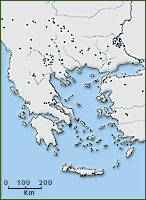The great number of imported vases in the grave circles of Mycenae shows that already from the early Mycenaean period the Mycenaeans had commercial exchange with countries of the East Mediterranean, Egypt and countries of the West. The reasons for such an unexpected and widespread development of trade lie in the strengthening of the central power and in the increased demand of metals which the Mycenaean leaders tried to ensure from the foreign markets. In the course of the 14th and 13th century the development of Mycenaean navigation and trade contributed considerably to the complete sufficiency of goods. The development of navigation and trade were also favoured by the international conditions, mainly the economic affluence of Syria and Palestine with which the Mycenaeans developed from very early commercial relations and the period of peace in the Mediterranean assured by the kingdom of Egypt which was concerned with internal reformations at that time. The international trade of the Mycenaeans was exclusively under the authority of the central power. The texts of the palace archives do not include evidence on the existence of a mercantile class. As money did not exist, trade was based exclusively on barter. The imported products which were now indispensable for the economy of Mycenaean Greece were mainly metals but the refined tastes of the leaders demanded the simultaneous import of valuable raw materials, such as gold, ivory and amber. Copper was imported from the mines of Cyprus and the Middle East. The search of tin, one of the most rare metals which was indispensable for the production of brass made the Mycenaeans reach Spain, the Baltic and perhaps Afghanistan. The exchange of these materials may have been made in the ports of the Mediterranean. In order to maintain the competitiveness of trade in the foreign markets, the Mycenaeans proceeded with the systematic export of agricultural products. The main exported products were: olive oil, scented oil and wine. Timber is considered to have been exported to Egypt which was always in need of wood due to the total absence of forests. Manufactured products such as weapons, vases and textiles were also exported. But exchange were not restricted only to products; they frequently included the exchange of people. Mercenaries were sent on military operations of foreign countries from which slaves were often bought on the mainland. The finds of the two shipwrecks of the Late Bronze Age which were discovered off the coast of Asia Minor, the Ulu Burun and Gelidonya shipwrecks, provide a live picture of the exchanges via sea routes. The Ulu Burun shipwreck dates around the 14th century BC. It is conjectured that the ship was Mycenaean. Many bronze and tin ingots as well as valuable objects of various kinds were pulled up from the ship ruins. The ship found near the coast of Gelidonya sank around 1200 BC and was probably a Phoenician one. Its load comprised many export products of the East Mediterranean among which many metal tools and bronze and tin ingots were found. |
 |
|
|
Bronze sources in the
Balkans and western Asia Minor during
the Bronze Age. |
||